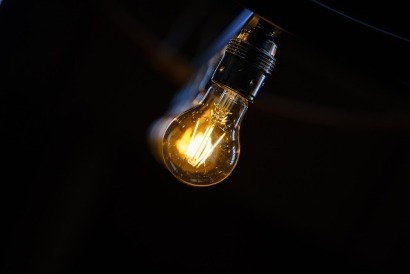
Lights extend your day and keep people safe. However, recent improvements were a long time coming.
Homeowners have struggled to balance artificial lighting with energy use since the first light bulbs. Incandescent bulbs are commonly used personally and industrially but have severe environmental consequences. The bulbs are the same technology Thomas Edison patented in the late 1800s. While the design continued to advance, the basic technology remained the same — using electricity to light a filament inside the bulb.
According to experts, lighting causes around 15% of global emissions. Not only do incandescents suck electricity through each day, but the heat they produce can also force your cooling system to work harder, using more energy.
Lights are essential to society and enable industries to operate throughout the night. Creating energy-efficient options was crucial in preserving the planet while still allowing critical medical, transportation and industrial tasks to happen.
Two significant advancements in light bulbs continue to improve the amount of energy used to light the world:
Incandescent bulbs are moving further into the past thanks to these advancements.
Almost every industry is taking on more efficient lighting options to save money and help save the planet.
The medical industry needs lights all the time. Hospital workers need to see their patients and equipment. Most hospitals utilize CFLs not just for their energy-saving abilities but also for their reliability.
The power of small LED lights is prominent throughout the tech industry. They are the standard for television, tablet and equipment screens, replacing bulky lamps that used to add weight and pixelation.
These lights are so beloved because they are cool to the touch, save energy and produce vibrant color. Many companies are further improving the lights by creating organic LED displays.
Work lights are vital for keeping workers safe during evening and night work, but previous models posed dangers. Traditional models used incandescent or CFLs, which heat up.
While CFLs save energy, they also produce significant heat. Work lights need a lot of power and could get so hot they could burn workers as they pass them. The industry is avoiding this problem by using LEDs in many modern work lights so they stay cool and bright throughout the project.
Heating, ventilation and air conditioning (HVAC) units are essential to commercial buildings — especially in the cold of winter or heat of summer.
Old HVAC units made everyone comfortable but used significant energy. Nearly 40% of buildings’ energy use is from these systems.
According to the Center for Climate Change, HVAC systems produce 441 million tons of carbon emissions annually. That makes these systems some of the top contributors to climate change. The primary problem is relying on these systems for comfort and safety. Thankfully, residential and commercial systems are improving yearly.
Modern HVAC systems are significantly better than those from past decades. A 20-year-old system can use multiple kilowatts of energy per hour, but current units often use less than one.
Smart thermostats are also contributing to reduced energy use. They allow users to control building temperatures remotely, and many models have sensors that can detect when someone isn’t in a room and use less energy for it.
These advancements have had a few key benefits in particular sectors.
The food and beverage industry relies on proper ventilation and consistent temperature to keep its products safe. Air flow also prevents kitchen fumes from impacting consumers and staff. Modern systems allow the sector to accomplish those goals while saving money and contributing to its carbon reduction goals.
Hospitals are notorious for being cold and there is a good reason. Keeping low temperatures helps limit bacterial growth, slowing the spread of illnesses. With such an important role, an energy-efficient HVAC system can reduce the environmental tax these vital facilities produce.
Vehicles are a vital part of life worldwide and contribute many emissions, but improvements make a big difference.
A typical gas-powered vehicle releases 4.6 metric tons of carbon per year. Petroleum gasoline pollutes the atmosphere and dramatically contributes to the greenhouse effect that accelerates climate change.
Many still use these vehicles and their fuel because they are the lowest-cost, easiest-to-use cars on the market. Key players in the automotive industry don’t have financial reasons to upgrade their vehicles to other power sources.
Many alternative fuels are developing worldwide, but the largest improvement is the growing electric vehicle (EV) movement. The demand for electric cars exploded in the past few years, with models becoming much more accessible. The 2022 US Inflation Reduction Act updated tax incentives for anyone operating certain EVs.
EVs offer a host of benefits to the environment, energy efficiency and the following industries.
The transportation sector benefits from electric vehicles thanks to government incentives. By upgrading fleets, businesses can save money on fuel cost and taxes. Whether transporting someone across town or a package across the country, a fully-electric fleet is the goal of many companies.
EVs also offer benefits to the construction industry. Electric cars paved the way for new electric models of traditional machinery, like bulldozers and forklifts. They help organizations save money and protect workers from continuous emission exposure.
Climate change is undeniable and threatens ecosystems, human health, and the planet's future. Large sectors can pave the way for a sustainable future by advancing energy efficiency.

